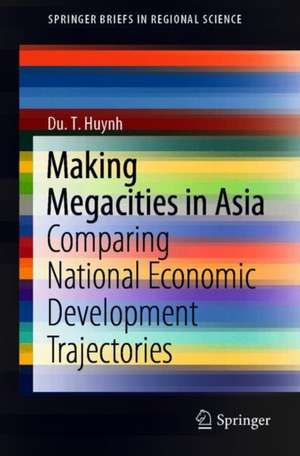Making Megacities in Asia: Comparing National Economic Development Trajectories: SpringerBriefs in Regional Science
Autor Du Huynhen Limba Engleză Paperback – 30 oct 2019
Preț: 379.68 lei
Nou
Puncte Express: 570
Preț estimativ în valută:
72.66€ • 78.90$ • 61.03£
72.66€ • 78.90$ • 61.03£
Carte tipărită la comandă
Livrare economică 22 aprilie-06 mai
Preluare comenzi: 021 569.72.76
Specificații
ISBN-13: 9789811506598
ISBN-10: 9811506590
Pagini: 125
Ilustrații: XX, 125 p. 17 illus., 16 illus. in color.
Dimensiuni: 155 x 235 x 14 mm
Greutate: 0.22 kg
Ediția:1st ed. 2020
Editura: Springer Nature Singapore
Colecția Springer
Seria SpringerBriefs in Regional Science
Locul publicării:Singapore, Singapore
ISBN-10: 9811506590
Pagini: 125
Ilustrații: XX, 125 p. 17 illus., 16 illus. in color.
Dimensiuni: 155 x 235 x 14 mm
Greutate: 0.22 kg
Ediția:1st ed. 2020
Editura: Springer Nature Singapore
Colecția Springer
Seria SpringerBriefs in Regional Science
Locul publicării:Singapore, Singapore
Cuprins
Introduction.- Seoul.- Manila.- Jakarta.- Shanghai.- Ho Chi Minh City.- Conclusion.
Notă biografică
Dr. Du T. Huynh is a senior lecturer at the Fulbright School of Public Policy and Management where he has taught since 2003. His teaching and research interests include urban economics, regional development, infrastructure development, and finance and banking. He worked at the Bank for Investment and Development of Vietnam from 1996 until 2005. He frequently participates in policy dialogue, and his research papers have appeared in a variety of prestigious international journals. Dr Du received an MPA from the Harvard Kennedy School of Government in 2010, and a Doctor of Design Degree from Harvard Graduate School of Design in 2013.
Textul de pe ultima copertă
This book analyses and compares the development paths of five major cities in East and Southeast Asia since the early 1960s, including Ho Chi Minh City, Jakarta, Manila, Seoul, and Shanghai. In examining these five cases through a carefully crafted conceptual framework, the author excavates an understanding of the dynamics that have enabled Seoul and Shanghai to become highly competitive as major engines of economic growth, while simultaneously accounting for why the other three cities have faced numerous problems in terms of meeting their development goals. Presenting both quantitative and qualitative data to trace the course of changes between 1960 and 2015, the case studies curate six possible explanations for the different cities’ developmental trajectories. The book considers the national development strategy matters to the development of cities and positions the share of budget revenue retained for cities’ expenditure as critical. The author demonstrates that consistentlypursuing long-term strategies is important, and that public entrepreneurship with powerful supporting coalitions is vital. The book illustrates how master plans have played limited roles in the building of cities, and that fragmented governments are often at the root of the problems facing a city’s development. This book will be highly relevant to researchers in international and Asian urban development.
Caracteristici
Analyzes and compares the impact of national development strategies in the development of the major cities in Asia between 1960 and 2015 Demonstrates the convergence and divergence of the development gaps between the major cities and the rest of a country in which they are situated Presents rich, original empirical data on the developmental trajectories of different cities











